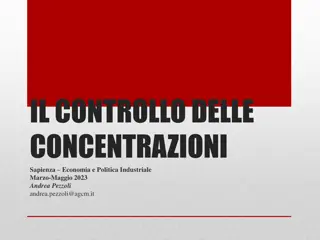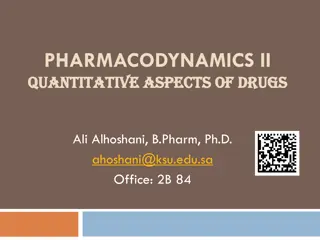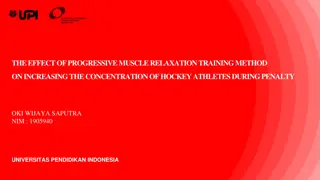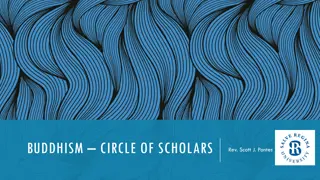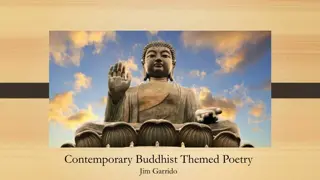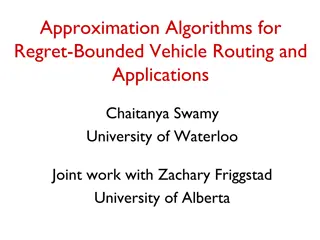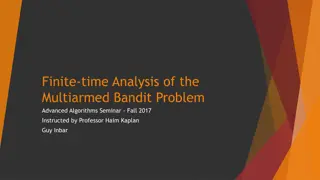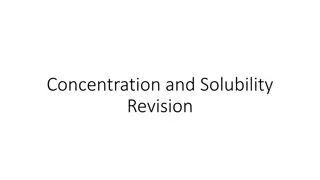Free from Regret: Transitional Stage in Buddhist Concentration Practice
Exploring the transitional stage between la and Samdhi Sun, this workshop delves into the multiple prerequisites for Buddhist concentration (samdhi) and the shared inner states that foster concentration. By overcoming the Five Hindrances, practitioners can achieve joy, rapture, tranquility, and ultimately concentration of the mind, leading to a deep sense of detachment and contentment.
Download Presentation

Please find below an Image/Link to download the presentation.
The content on the website is provided AS IS for your information and personal use only. It may not be sold, licensed, or shared on other websites without obtaining consent from the author.If you encounter any issues during the download, it is possible that the publisher has removed the file from their server.
You are allowed to download the files provided on this website for personal or commercial use, subject to the condition that they are used lawfully. All files are the property of their respective owners.
The content on the website is provided AS IS for your information and personal use only. It may not be sold, licensed, or shared on other websites without obtaining consent from the author.
E N D
Presentation Transcript
Free from Regret: One Transitional Stage Bridging Between la and Sam dhi Sun, Hao Numata Center for Buddhist Studies at the University of Hamburg Revised version for Meditation in the Clinic? Workshop at HUJI, Jerusalem, 2019.5.12-14
1. Multiple prerequisites for Buddhist concentration (samdhi) 2. Shared inner states of a virtuous person towards concentration 3. Conclusion 1
1.1 Free from the Five Hindrances fosters concentration One (a Bhikkhu) who is endowed with noble morality, noble guarding of sense organs, noble Mindfulness and thorough understanding and noble contentment when he perceives that he is free from the Five Hindrances (pa ca n vara e pah e), joy (p mojja) arises; the joyful one has rapture (p ti); the one with rapture tranquillizes [his] body; the one with tranquil (passaddha) body feels pleasure (sukha); the one with pleasure concentrates (sam dhiyati) [his] mind. Being detached from sense-desires, detached from unwholesome states, he enters and remains during the first jh na, which is with rough and subtle examination, born of detachment, filled with rapture (p ti) and pleasure (sukha). And with this rapture and pleasure born of detachment, he so suffuses, drenches, fills and irradiates his body that there is no spot in his entire body that is untouched by this rapture and pleasure born of detachment. 2
1.1 Free from the Five Hindrances fosters concentration So imin ca ariyena s lakkhandhena samann gato, imin ca ariyena indriyasa varena samann gato, imin ca ariyena satisampaja ena samann gato, im ya ca ariy ya santu hiy samann gato Tass'ime pa ca n vara e pah e attani samanupassato p mojja j yati, pamuditassa p ti j yati, p timanassa k yo passambhati, passaddhak yo sukha vedeti, sukhino citta sam dhiyati. So vivicc'eva k mehi, vivicca akusalehi dhammehi savitakka savic ra vivekaja p tisukha pa hamajjh na upasampajja viharati. So imam eva k ya vivekajena p tisukhena abhisandeti parisandeti parip reti parippharati, n ssa ki ci sabb vato k yassa vivekajena p tisukhena apphuta hoti. See D ghanik ya, Sama aphalasutta. 3
1.2 The Five Hindrances in the Dghanikya Katame pa ca? K macchandan vara a , by p dan vara a , thinamiddhan vara a , uddhaccakukkuccan vara a , vicikicch n vara a . See D ghanik ya, Tevijjasutta. Which five [hindrances]? [1] Hindrance of longing for (sensual) pleasure/ pleasure of the senses; [2] Hindrance of malice/ill-will; [3] Hindrance of sloth/laziness and torpor; [4] Hindrance of restlessness and regret (kukkucca); and [5] Hindrance of doubt. 4
1.3 The Five Hindrances in the Samhitbhmi (2.2.0) tatra pa ca nivara ni dhy nasam patty vara ni y ni dhy nasam pattik la vara a kurvanti: k macchandanivara a vy p dasty namiddhauddhatyakauk tyavicikits nivara a ca. (Delhey 2009: 131) Then, there are Five Hindrances as obstacles of dhy na-equipoise making obstacles on the occasion of dhy na-equipoise. [These five are]: [1] Hindrance of longing for (sensual) pleasure/ pleasure of the senses; [2] Hindrance of malice/ill- will; [3] (Hindrance of) sloth/laziness and torpor; [4] (Hindrance of) restlessness and regret (kauk tya); and [5] (Hindrance of) doubt. 5
1.4 Another Buddhist path towards concentration Three stages viz. morality ( la), concentration (sam dhi) and insight (praj ) directed towards nirv a in the Buddhist tradition. Morality ( la) as a taken-for-granted prerequisite for concentration (sam dhi) Multiple schemas to obtain Buddhist concentration 1. Free from the Five Hindrances (including regret) 2. Possessing good behaviours 6
2.1 Well-purified right conduct underpins concentration in the r vakabh mi suvi uddha lasya avipratis ra | avipratis ri a pr modya pr ti prasrabdhi sukham, sukhitasya cittasam dhi sam hitacitto yath bh ta praj n ti yath bh ta pa yati | yath bh ta j nan pa yan nirvidyate nirvi o virajyate | virakto vimucyate | vimukto 'nup d ya parinirv ti | r vakabh mi II 132 Translation: For the one who has well-purified right conduct he/she is free from regret. For the one who is free from regret [due to purified right conduct] he/she has joy, rapture, ease/tranquility, and pleasure. The one who is full of pleasure has mental concentration. The one whose mind is concentrated, he/she knows and sees [things] according to the truth. [The one who] knows and sees [things] according to the truth, he/she becomes disenchanted, and dispassionate (with sa s ra). [The one who] is dispassionate (with sa s ra) is liberated. The liberated one reaches Nirvana after having not grasped (to existence). 7
2.2 Counterpart in the Pali Aguttaranikya: part I The Venerable nanda approached the Blessed One, paid homage to him, sat down to one side and said to him: Sir/bhante, what is the purpose (kim atthiyo) and benefit (kim nisa so) of wholesome virtuous behavior (kusal ni s l ni)? nanda, the purpose and benefit of wholesome virtuous behavior is free from regret (avippa is ra). Sir/bhante, and what is the purpose and benefit of [the state of] free from regret? nanda, the purpose and benefit of [the state of] free from regret [due to wholesome virtuous behavior] is joy (p mojja). Sir/bhante, and what is the purpose and benefit of joy? nanda, the purpose and benefit of joy is rapture (p ti). Sir/bhante, and what is the purpose and benefit of rapture? nanda, the purpose and benefit of bliss is ease/tranquility (passaddhi). Sir/bhante, and what is the purpose and benefit of ease/tranquility? nanda, the purpose and benefit of ease is pleasure (sukha). Sir/bhante, and what is the purpose and benefit of pleasure? nanda, the purpose and benefit of pleasure is concentration (sam dhi). (to be continued) 8
2.2 Counterpart in the Pali Aguttaranikya: part II Sir/bhante, and what is the purpose and benefit of concentration (sam dhi)? nanda, the purpose and benefit of concentration is the knowledge and vision of [things] according to the truth (yath bh ta adassana). Sir/bhante, and what is the purpose and benefit of the knowledge and vision of things as they really are? nanda, the purpose and benefit of the knowledge and vision of things according to the truth is disenchantment (nibbid ). Sir/bhante, and what is the purpose and benefit of disenchantment? nanda, the purpose and benefit of disenchantment is dispassion (vir ga). Sir/bhante, and what is the purpose and benefit of dispassion? nanda, the purpose and benefit of dispassion is the knowledge and vision of liberation (vimutti adassana). See A guttaranik ya Dasakanip ta & Ekadasakanip ta Kimatthiyasutta 9 Translated based on Bodhi 2012: 1553 1554
2.3 Purified by Buddhist confession and remedy of faults in the r vakabh mi If he (a Buddhist monk) who is introspecting [himself] knows that my previous karma produced via body has caused injury or oppression ; [later] he confesses in front of fellows/companions (sabrahmac ri ) endowed with [good] knowledge and he remedies [his faults] according to dharmas. If [then] he who is introspecting [himself] knows that my previous karma produced via body has not caused injury or oppression [to others] , he practises many days and nights with rapture and joy, then his introspected previous karma produced via body is purified in the past, future and present time. Likewise [his] karma produced via body and talk should be known in this way. 10
2.3 Purified by Buddhist confession and remedy of faults in the r vakabh mi: Skt sacet sa eva pratyavek m o j n ti vy b dhika me etat k yakarma p rvavat / savij n sabrahmac ri m antike pratide ayati, yath dharma pratikaroti / sacet punar eva pratyavek am o j n ty avy b dhika me etat k yakarma p rvavat / sa tenaiva pr tipr modyen hor tr nu ik bahula viharaty, evam asya tat k yakarma supratyavek ita ca bhavati, suvi odhita ca yadut t t n gatapratyutpanne v adhvasu // yath k yakarmaiva v kkarma veditavyam // r vakabh mi Study Group 1998: 90. 11
2.4 Extended exposition in the Bodhisattvabhmi a bodhisattva undertaking the morality as controlling [his/her] body and speech (k yav ksa vara la sam dad no bodhisattva ) he/she gets rid of misconduct which is the opponent of the right conduct; ( lavipak a dau lya prajah ti) That bodhisattva gets rid of fear, condemnation and hostility caused by misconduct and benefits him- or herself. That bodhisattva sleeps well and wakes up well. In this way, the virtuous one (bodhisattva), due to being free from regret, has joy and so on, up to concentration. Thus, (a bodhisattva) benefits him- or herself. (dau lyapratyaya bhayam avadya vaira prajahad tm nam anug ha ti sukha svapan sukha pratibudhyam na | tath lavato 'vipratis ra pr modya y vac cittasam dhi | ity evam tm nam anug h ti | ) Through non-hurting a bodhisattva bestows a sense of safety upon all sentient beings. Thus a bodhisattva also benefits others. (sarvasattv n ca sarvaprak rair avihe hanatay abhayam anuprayacchati | eva param apy anug h ti |) 12
2.4 Exposition in the Bodhisattvabhmi: text k yav ksa vara la sam dad no bodhisattva lavipak a dau lya prajah ti | bodhe ca sa bh rabh ta bhavati tad asya lasam d nam | sam n rthatay ca sa grahavastun sattv n parip cayati | dau lyapratyaya bhayam avadya vaira prajahad tm nam anug h ti sukha svapan sukha pratibudhyam na | tath lavato 'vipratis ra pr modya y vaccittasam dhi | ity evam tm nam anug h ti | sarvasattv n ca sarvaprak rair avihe hanatay abhayam anuprayacchati | eva param apy anug h ti | tannid na ca k yasya bhed t sugatau svargaloke deve papadyate | ity aya catur k ra prabh va lasya | n ta uttari n to bh ya | Dutt 1966: 50 51 13
2.5 Philological analysis of avipratisra Avipratis ra and vipratis ra avippa is ra (in Pali): (lit) non-regret according to Bodhi 2012: 1553 Dhammat es , bhikkhave, ya s lavato s lasampannassa avippa is ro uppajjati in the Cetan kara yasutta in the A guttaranik ya, Dasakanip ta It is natural that non-regret arises in a virtuous person, one whose behaviour is virtuous. see Bodhi 2012: 1340 My interpretation: [the state of] (having) no[thing to] regret or free from regret. vipratis ra: vi+pa is ra bad conscience, remorse, regret PTS P-E Dictionary turning back, regression BHSD pratis ra 14
2.6 Philological analysis of kauktya Tri ik vij aptibh ya kauk tya cetaso vipratis ra | kutsita k tam iti kuk tam | tadbh va kauk tyam | iha tu kuk tavi aya cetaso vilekha kauk tya caitasik dhik r t | etac ca cittasthitiparipanthakarmakam | see B scher 2007: 98, 8 10 Translation: remorse (kauk tya) is mental reget (vipratis ra). What is called done falsely (kutsitam) is kuk ta. Its (kuk ta) abstractive [noun] form (tadbh va) is kauk tya. But on account of the topic ( dhik ra) caitasika here (in this context) mental disturbance/annoyance (vilekha) has the object of kukrtya [as being recognized]. It (etad refers to kauk tya) has the function of interfering mental stability (cittasthiti). 15
2.7 Exposition of kauktya in the Samhitbhmi 1. Reflection such as Why did I leave my kinsmen? Why did I not go to that community? Why did I come here? Why did I become a monk at young age? (Why did I) in spite of the wishes of crying and weeping kinsmen become a monk? 2. Reflection when remembering former jokes and recreation and so, [and thinking]: Why did I at that time amuse myself with recreation, enjoyment, and adornment? 3. Furthermore, for the one has done or not done something that should be or not be done (kara y kara ya) according to circumstance [and thinking] what ought to be done is not done by me; what ought not to be done is done by me. 4. The possession of kauk tya (kauk tyaparyavasth na) is unable to (a aknuvat) remove (vinodayitum) in the future (uttarak la), that became the continuing (pr bandhika) mental disturbance ( lekha), remorse (kauk tya) and regret (vipratis ra). This is another sort of the kauk tya-hindrance. 16
2.7 Elucidations of kauktya in the Samhitbhmi (2.2.1.4.2) what is kauk tya? For ones who are reflecting/making rough examination (vitarkayat) on their kinsmen and so on (j ty di), [and thinking]: Why did I leave my kinsmen? Why did I not go to that community? Why did I leave that community and come here (tyaktveh gata), where such food is eaten, such drink is taken, and such dress (c vara), alms (pi ap ta), sleeping place ( ayana), seat ( sana), medicament having sickness as its cause (gl napratyayabhai ajya) and personal belongings (pari k r ) are obtained? Why did I become a monk at young age? It should be made (becoming a monk) when I am old! , or when remembering former jokes and recreation and so, [and thinking]: Why did I at that time amuse myself with recreation, enjoyment, and adornment? (Why did I) in spite of the wishes of crying and weeping kinsmen become a monk? With [above] such causes kauk tya that is mental disturbance (vilekha), remorse ( lekha) and regret (vipratis ra) arose ... Furthermore, for the one has done or not done something that should be done or not be done (kara y kara ya) according to circumstance [and thinking] what ought to be done is not done by me; what ought not to be done is done by me. Thus having established kauk tya for the first time. The possession of kauk tya (kauk tyaparyavasth na) is unable to (a aknuvat) remove (vinodayitum) in the future (uttarak la), that became the continuing (pr bandhika) mental disturbance, remorse (kauk tya) and regret (vipratis ra). This is another sort of the kauk tya-hindrance. 17
2.7 Elucidations of kauktya in the Samhitbhmi (2.2.1.4.2) kauk tya katamat? t n eva j ty divitark n vitarkayata : kasm d aha tebhyo j tibhyo viyukta , ta v janapada na gata , ta v janapada tyaktveh gata , yatraiva r pa kh dyaka kh dyate, p naka p yate, eva r p c varapi ap ta ayan sanagl napratyayabhai ajyapari k r labhyante? kasm d aham eva dahra pravrajita ? t vad sito bhavi ya y vad v ddh vasth t! , paur a v hasitakr it di samanusmarata : kasm d aha yasmin samaye kr ratima anasth nayogam anuyuktena vihartavyam, tasmin samaye k mak n j t n s ruka h n rudanmukh n pravrajita ? ity eva r pe a pratyayena ya utpadyate cetasa lekho vilekha kauk tya vipratis ra ... kara y kara ya v punar yath yoga k tavato v k tavato v k rya me na k tam, ak rya me k tam iti tatprathamata utpanna kauk tya sth payitv tad eva kauk tyaparyavasth nam a aknuvato vinodayitum uttarak la yad utpadyate pr bandhika cetasa lekho vilekha kauk tya vipratis ra ity ayam apara kauk tyanivara apary ya . (Delhey 2009: 133 135) 18
2.8 Shared inner states of a virtuous person starting from free from regret towards concentration Skt: lavi uddhi Tib: tshul khrims tu rnam par dag pa Chn: (Pali: kusal ni sil ni) [A person with] purified right conduct or wholesome right conduct Free from regret ease/ concentration pleasure joy rapture tranquility Skt: avipratis ra Pali: avippa is ra Tib: gyod pa med Chn: Skt: pr modya Pali: p mojja Tib: dga ba Chn: Skt: cittasam dhi Pali: sam dhi Tib: ting nge dzin / mnyam par jog go Chn: Skt: pr ti Pali: p ti Tib: mchog tu dga ba Chn: Skt: prasrabdhi Pali: passaddhi Tib: shin tu sbyangs pa Chn: Skt: sukha Pali: sukha Tib: bde pa Chn: (Pali: *kukkuccan vara a pah a from pa ca n vara e pah e) 19
2.9 Exegesis of the inner states in the Samhitbhmi (2.1.2.1) pr modya katamat? di uddhasya sa bh rabh mi pari uddh vyavalokayato yad avipratis rap rvik ttamanaskat pr modya saumanasya cittakalyat . The one who is initially pure looking at his pure provision-stage has pr modya, which is pleasantness, satisfaction and the delighted state [due to] being free from regret previously. (2.1.2.2) pr ti katam ? ya samyakprayogap rvako har a pr ti saumanasya cittakalyat . Rapture is satisfaction and pleasantness, rejoicing resulting from previous correct practice. (2.1.2.3) prasrabdhi katam ? dau huly pagam t k yacittakarma yat . Physical and mental malleability from the elimination of the noxiousness. (2.1.2.4) sukha katamat? tath karma yacittasya yat k yikacaitasikam avy vadhyasukha vimuktisukham. yatpak ya hi tad dau hulyam apagatam, tebhya upakle ebhyo vimukti . The impregnable physical and mental pleasure; the pleasure of liberation who has thus a malleable mind; liberation from the secondary defilements to which the eliminated noxiousness belongs (2.1.2.5) sam dhi katama ? samyag lambanam upanidhy yato yac cetasa aik gryam. The one who is reflecting correctly upon one (meditative) object has concentration Sanskrit texts see Delhey 2009: 129 130. 20
3 Conclusion (1) Two prerequisites to obtain Buddhist concentration viz. either (a) via removal of the Five Hindrances or (b) via good behaviours converge on the inner states starting free from (the hindrance of) regret (avippa is ra/avipratis ra or *kukkuccan vara a pah a included in pa ca n vara e pah e) joy (p mojja/pr modya) rapture (p ti/pr ti) tranquility (passaddhi/prasrabdhi) pleasure (sukha) concentration (s madhi) stated in the early Pali Nik ya and in the later sophisticated Sanskrit Yog c rabh mi. Yet, after obtaining concentration (s madhi), rapture (p ti) and pleasure (sukha) still remains during the first jh na in the D ghanik ya. (2) On the contrary, regret (kauk tya or vipratis ra which are synonyms in the Sam hit bh mi) arising largely from misconduct disturbs concentration. In case of previous bad karma, one can confess in front of fellows endowed with good knowledge and remedy [his/her faults] according to dharmas, then his/her karma [and behaviour] is purified, so that one can be free from regret as expounded in the r vakabh mi. (3) In spite of relying almost on the same procedure, different Buddhist scriptures appear to enjoy slightly varied flavours, as kusala in the Pali Nik ya, suvi uddha la in the r vakabh mi and altruism in the Bodhisattvabh mi. 21


